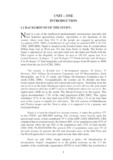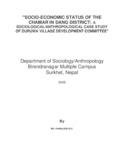Please use this identifier to cite or link to this item:
https://elibrary.tucl.edu.np/handle/123456789/3514| Title: | Socio-Economic Status of The Chamar in Dang District: A Sociological/Anthropological Case Study Of Duruwa Village Development Committee |
| Authors: | D.C, Kamalesh |
| Keywords: | socio-economic;sociology |
| Issue Date: | 2009 |
| Publisher: | Department of Sociology/Anthropology Birendranagar Multiple Campus Surkhet |
| Level: | Masters |
| Abstract: | "Socio-economic Status of the Chamar in Dang District: A Sociological/Anthropological Case Study of Chamar(Chamar) Community at Duruwa Village Development Committee" wards no. 5 Monoharpur was selected purposively. This study was carried out from February 1st to April last 2009, Asses the Socio-economic status of the Chamar in Durawa VDC. The Chamar of the Durawa VDC have been found to be very behind socially dominated by other caste group of Dang District of Nepal. There are 35 house holds (including ward no.1) of Chamar and the populations of them are 221 only. Mainly primary data are used focusing on qualitative in nature. Descriptive and analytic method is used in this study. Chamars are traditionally leather worker and migrated from India to Nepal. Dangali Chamar are also Migrated from India but they first came in Deukhuri and then after they came to Dang. When they came in to Duruwa VDC. They started in watchman, but they all did traditional leather work. During a long period of time leather work and village watchman had become scarce and they gradually started to shift a way from their traditional occupation. Now they are depending upon agriculture and labour. Chamars are religiously Hindu; they worship Hindu God and Goddess. Similar to Bramin and Chhetris, they mainly celebrate Dashin, Tihar, Teej and Maghesakranti. They play traditional type of band which is known as Chamare Baja. Especially they play their band at wedding time. Chamar are considered as untouchable according to Hindu caste hierarchy, they are Shudra. The finding of the study shows that the Chamar of that study area were very behind in education, occupation and economy. They have very poor, exploited by higher caste group most of them are landless and they are in backward in each and every field. They had a crucial problem of land, drinking water, electricity, irrigation and communication system. They had very small piece of land and some of them don't have land in own name. They speak Nepali language but they have own native Abadhi language. They have no traditional type of dress and ornamentals. The men and women work together and have good friendly social relation within or without the religious group of the study area as well. The caste based discrimination is not so rigid as it was in the past but few discrimination can be seen clearly they can't enter in the house of the higher caste group. Water is not allowed to get Chamar hand in study area. They should be given a deep attention by empowering them and should be included them in all developmental activities, to improving the standard of living of the Chamar people in the study area. |
| URI: | http://elibrary.tucl.edu.np/handle/123456789/3514 |
| Appears in Collections: | Sociology |
Files in This Item:
| File | Description | Size | Format | |
|---|---|---|---|---|
| Chapter Page(1).pdf | 602.22 kB | Adobe PDF |  View/Open | |
| Cover Page(6).pdf | 52.71 kB | Adobe PDF |  View/Open |
Items in DSpace are protected by copyright, with all rights reserved, unless otherwise indicated.
